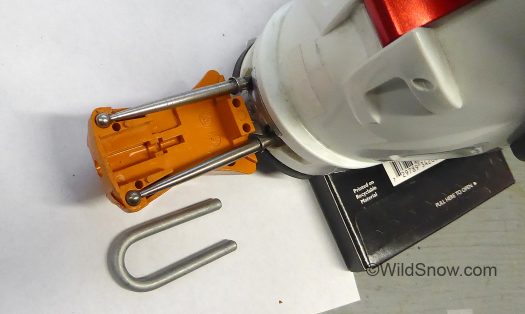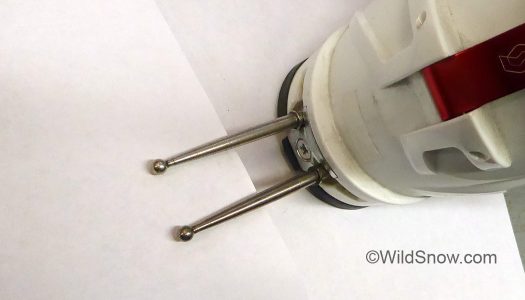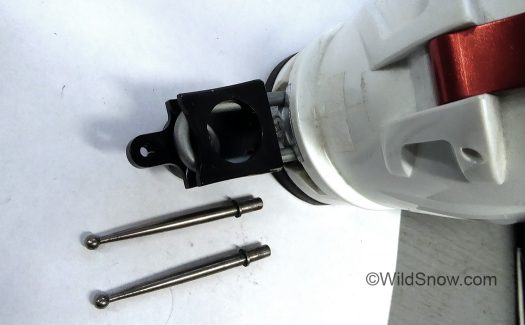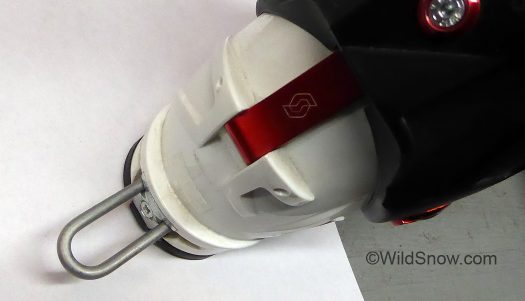(Post sponsored by our publishing partner Cripple Creek Backcountry.)
With their new Alpinist binding (available fall of 2018), Marker returns to the roots of our sport and introduces its lightest-ever ski touring clamp (other Marker offerings for example Kingpin and Duke). These are a fairly traditional tech design using the “U-pin” type heel pins (see our exposition below). The heel provides three climbing lifts which are average in height compared to other bindings. The U-pin heel yields a fixed upward release value with adjustable lateral release. Boot length adjustment is 15 mm (longer demo version available).
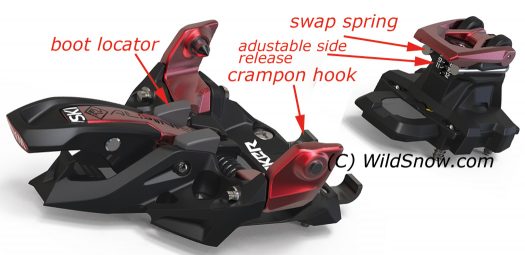
Marker Alpinist is another clone of the original Barthel tech binding design, including fixed vertical release adjusted by swapping heel springs.
Alpinist comes stock with the heel spring said to yield “high setting” vertical release, for example the Alpinist 12 will presumably have something like a 12 DIN vertical heel release, with Alpinist 9 providing its eponymous setting as well. That of course could be problematic if you’re needing lower settings — remedy is similar to other brands, in that Marker will sell optional release value springs: two others in addition to what the binding comes with. The springs made for both bindings are used for both the 9 and 12 versions of the binding, meaning the “medium” spring is used as the stock spring for the 9, and the “high” spring is used for the stock spring for the 12. One could presumably install the “high” spring in the model 9 and end up with a model 12, or the reverse. That’ll all be researched over coming months.
(Please note that the acronym “DIN” is used here with the qualifier “something like” since as far as we know these bindings are not certified by TUV to the DIN ski touring binding standard 13992, thus, the term “DIN” should instead be “RV” for release value.)
We’d prefer see four spring options available for fine tuning all brands of “rear U-pin” bindings (see below for explanation of “U-pin”). Mainly, be careful with these pre-set bindings; lighter weight skiers can end up with a rig they can’t step into, let alone release out of.
For the official take, see Marker’s mini-site. Marker also recently hosted a press event in Europe, as a result just google it up and you’ll find plenty of information. Our data block as at bottom of this post.
While we wait for our own sample of the Alpinist, as a service I should get into more detail about the differences between rear U-pin bindings and those with separate heel pins we’ll call “rear free-pins” for want of a better term. Aside from the rear U-pin springs not being adjustable in vertical release tension, they don’t rotate as separate rear free-pins do. I’ve spoken with several binding makers who’s research and testing has shown that uneven and accelerated wear on non-rotating binding heel U-pins and associated boot fittings causes a fairly rapid change in release-retention characteristics as well as how the binding behaves during step-in (for skiers who do plenty of downhill mode use of such bindings). I’ve seen this on our own bench, though I’ve not done any formal measurements.
What’s the advantage of rear U-pins as used by Marker? Simple, they’re lightweight and in a word, simple. The concept is not going away (we’re fine with Marker’s take), but makers of such bindings need to be doing three things:
While consumers need to be aware of the compromises, not to mention what exactly is a free-pin binding heel as opposed to U-pin? Well, here you go:
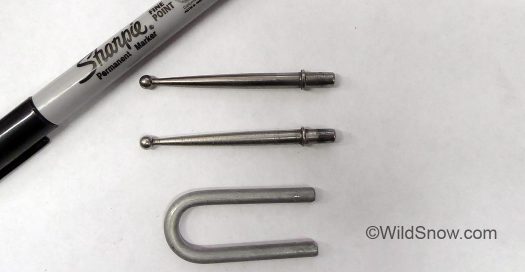
Typical tech binding heel pins, separated ‘free-pins’ (top) are free to rotate, U-pin (bottom) is a more archaic technology that may wear faster and not offer easy tension adjustment, but has advantages of simplicity. Heel pins are part of the heel unit assembly, and insert into the boot heel fitting. The use of heel U-pins is what we feel defines a “classic” tech binding, as opposed to “hybrid” tech bindings that boast alpine-like heels, best example being Fritschi Tecton.
Marker Alpinist Data
Weight per binding, no brake: 245 grams
Weight, typical brake: 90 grams
Tech gap at heel: zero
Wide screw hole pattern: 38 mm
Ski flex compensation: 4 mm
Brake widths: 90/105/115 mm
Crampon widths: 80/90/105/120 mm
Regular version boot length adjustment 15 mm, longer demo version as well
WildSnow.com publisher emeritus and founder Lou (Louis Dawson) has a 50+ years career in climbing, backcountry skiing and ski mountaineering. He was the first person in history to ski down all 54 Colorado 14,000-foot peaks, has authored numerous books about about backcountry skiing, and has skied from the summit of Denali in Alaska, North America’s highest mountain.

